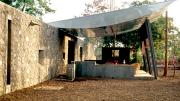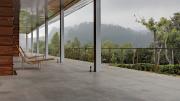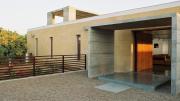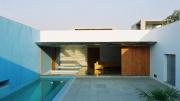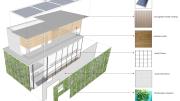My article (“Designs for a New India”) explores some of your projects that are open to the public, but you also design private homes. Tell me about some of your favorite residential projects.
A lot of the houses are country homes for people from Mumbai. Because there are such pronounced socioeconomic, cultural, professional, and perhaps even ethnic and linguistic differences between these people and their neighbors, I’ve been very conscious of this idea of “softening thresholds.”
We did a house for a young filmmaker, and the house’s living room was just a big portico. The owners would use it on the weekends, and then when they left they would move their furniture inside, lock the doors, and the villagers and especially the caretaker and his family (who are from the adjacent village) could use the portico during the week when the owners weren’t there. We also designed a way to collect rainwater to feed the existing well, and installed a tap so anyone could come and get water. It became an implied community space for the village. I believe a wedding even took place there.
We built another house at a tea plantation. The owner initially suggested we get rid of the tea and make a lawn. I insisted we keep the tea and put the house at the edge of the plantation. He owns India’s biggest machine-tool company, so he doesn’t need the proceeds from selling a bit of tea. But the house is in the middle of a tea-growing area where people are buying up land and eliminating the tea plants. Preserving the tea keeps the ecology more stable and keeps a few local people employed by allowing them to harvest the tea and sell it. This solution also integrates the weekend house better in the productive landscape of the area, rather than isolating the house by converting it all to a traditional manicured garden.
There are still tremendous disparities, and I’m not saying this is a solution, but it’s a gesture—and in these little gestures, change begins. At many country houses, the owners close their gates and build high walls with security systems—and they have break-ins. There’s never been a break-in at one of the homes we designed, and I think this is because aesthetically, they are not ostentatious, but welcoming and transparent.
All of your designs seem to have many layers of meaning. It isn’t just about the way a building looks or its primary function; your designs often encourage using spaces in multiple, unexpected ways, with nods to social and cultural factors. Was this always your approach, or has it evolved over the years? What drives you to want to make such complex creations?
I think this has evolved over time, largely because of my many
engagements, ranging from architectural practice to writing and directing a
research institute. I have tried not to be just an architect, but to draw
inspiration from history and the state of the contemporary city, as well as to work collaboratively with people and organizations. So for me, Mumbai itself
has really generated my practice and the directions it’s taken, and getting to
know the different constituent groups in the city has made me aware of the role
that architecture can play in creating, dissipating, and softening thresholds
between these groups.
This idea—how architecture can deepen social divides, depending on how it is used—is a major theme in your work, and obviously something you care deeply about. Do you ever have a private client who wants to build a very ostentatious house? How do you handle that?
I try to steer my wealthy clients toward “introverted
worlds”—marble floors, nice fixtures. Ostentation on the inside rather than the
outside. Polarization occurs when wealth is flaunted, and architecture can get
coopted in that process.
In your work, you interact with the poorest of the poor—slum children—and the complete opposite end of the spectrum—for example, a princess from one of India’s former royal families that still possesses very significant wealth. Do you ever feel culture shock because of this? What do you think enables you to navigate both of those worlds with ease?
I think you just grow up like that in India, because one is surrounded by disparities and cultural differences.
In order to slip between these worlds very easily, you have to deal with each one on its own terms. People get in trouble when they try to deal with different groups on their own terms and use the same approach for everybody. For instance, there are people the princess can’t meet with, things I can access and harness for the project that she can’t. It’s the same with the child in the slum—there are certain people his life story resonates with, and there are others he just can’t connect with, and I can help facilitate. Depending on the client, you adjust your own contributions to open up connections and ultimately soften the thresholds—virtual and real—that separate people.
One of the projects I didn’t get a chance to mention in my article was
the public toilet building you designed. Tell me about that.
We built a public toilet in a slum called Sakinaka. The government was funding this project through the NGO SPARC (Society for the Promotion of Area Resource Centres) and the National Slum Dwellers Federation, and I just thought it was a pity that they always use these identical concrete blocks that deteriorate very fast. So we approached the groups involved and began assisting them in evolving the design. Compared to the regular design, ours has several innovations.
We “wrapped” the toilet building in a wall of greenery, so people begin to see it as pleasant rather than being this unsanitary thing that is badly kept. For a time, the government halted construction, and I think this was because a building with some beauty would signal that the slum was there to stay if an investment was being made in improving the infrastructure. If a toilet becomes a thing that’s attractive, then the government’s argument for removing slums is challenged. I’m just conjecturing. I could be dead wrong. But I see no other reason.
We also put solar panels on the toilet building’s roof. I went to a client whose house I had designed and asked him to donate the panels. (I also donated my time to design this project.) Solar power takes the toilet off the grid so it won’t have to be run by a contractor. Contractors charge a rupee or two to use the toilet so they’ll be able to cover the electricity bill, but then they often remove the lightbulbs to save money. And when that happens, women and children don’t find the toilet safe so they don’t use it at night.
The solar panels also power lights on the veranda, so it
becomes a space where children can come and study at night. On the floor above
the toilets are living quarters for the caretaker’s family. The veranda is also a place where people can get a view of the slum—to get away from the
claustrophobia one can experience in such a densely populated setting. So it
becomes more a community center than a toilet.
You travel back and forth to India so often. Do you still get jetlag?
I do. It’s a week of suffering every time!
